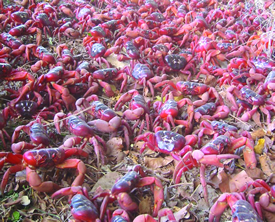
Dimdima
Online Children's Magazine from India

Dimdima
Online Children's Magazine from India




CHRISTMAS Island is situated in the Indian Ocean about 360 kilometres south of Java in the Indonesian archipelago.
Around 1875 the British naturalist, Sir John Murray, stopped here while on an oceanographic expedition. He analysed soil and rock samples and found them rich in phosphates. This brought European mineral companies to the island and, by 1888, the first settlement was established.
Sir John urged the settlers not to tamper with the ecology of the island and the settlers seem to have heeded his request. Today, after more than a century of human habitation, the 135-square-kilometre island is still thickly forested and it is home to eight species of seabirds, three of which are not found anywhere else in the world.
Several species of crab are found here, including the giant robber crab, but the dominant species is the red crab. According to one estimate there are 120 million red crabs on Christmas Island!
Towards the end of the year when the rainy season begins, these crabs start migrating from a plateau in the interior where they dwell, to the sea. They cover the land like a vast red carpet as they crawl down to the coast, eating all the leaves, flowers and fruits fallen on the ground, on the way. When they've passed, it looks as if a giant broom has swept the area clean.
It takes them about a week to reach the sea. Many thousands die on the way, either due to dehydration or in encounters with cars and trucks. Fortunately for them they are not good to eat, so people leave them alone.
The migration has a purpose: the propagation of the species. The crabs mate and then the males leave, going back to the plateau from where they had come. The females wait till the eggs which they carry on the underside of their bodies are ready to hatch. Then they drop the larvae in the sea and return home.
The larvae, in the course of several weeks, develop into young crabs and come ashore. From here they slowly make their way inland, instinctively heading for their ancestral home on the plateau.
Last updated on :6/15/2015
EXPLORE MORE...
COMMENT ON THIS ARTICLE
Wants to share something related to this article? Please use the form below.
Dimdima is the Sanskrit word for ‘drumbeat’. In olden days, victory in battle was heralded by the beat of drums or any important news to be conveyed to the people used to be accompanied with drumbeats.
Bharatiya Vidya Bhavan
K. M Munshi Marg,
Chowpatty, Mumbai - 400 007
email : editor@dimdima.com
Bharatiya Vidya Bhavan
505, Sane Guruji Marg,
Tardeo, Mumbai - 400 034
email : promo@dimdima.com
Dimdima.com, the Children's Website of Bharatiya Vidya Bhavan launched in 2000 and came out with a Printed version of Dimdima Magazine in 2004. At present the Printed Version have more than 35,000 subscribers from India and Abroad.